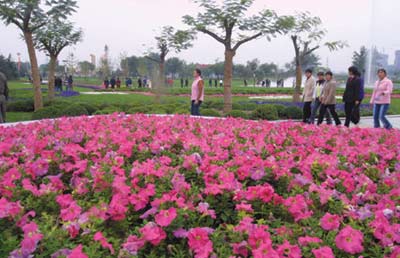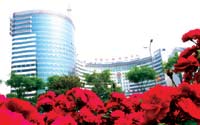| Hopes for a Greener China |
| http://www.sina.com.cn 2004/11/25 20:32 thats China |
 Hopes for a Greener China Will the Smoke and Soot Clear Out in the near Future? By Geoffrey Murray Spring used to be a time of torment for people living in China; Beijing residents in particular. Every year, bitterly cold winds sweeping south from Siberia and Mongolia tended to pick up sands from the deserts of northern China and deposit them on the capital. Being outside then meant exposure to an unpleasant, sandpapering experience. Entering the 21st century however, the storms no longer seem to occur with the same frequency and intensity. The improvement is the reward for years of hard work in grass and tree planting to stabilize the soil of the northern deserts. Unfortunately, desert sand has not been the only unpleasantness experienced by the capital's residents in recent decades. A scenic mountain range forms Beijing's western boundary. For decades, a huge pall of smog fed by the blast furnaces of Shougang (Capital Iron and Steel Works) - Beijing's biggest industrial enterprise - obscured the charm of this highland.
This is no longer the case. Shougang's steel-making activities have been transferred out of the area, along with the rest of the city's potentially polluting manufacturing industry. Meanwhile, coal has been largely replaced by natural gas piped from under the deserts in China's far west as a form of domestic heating. These are the most visible changes any repeat visitor or long-term resident of Beijing will notice in the new century, and they were ones that first made me interested in how China was tackling its environmental problems. Two things emerged: First, China is making massive efforts to overcome decades of inattention to underlying environmental problems; second, the problems are so extensive and so complex, that they cannot be tackled successfully without the total commitment of everyone in China over a long period. The cessation of the spring sandstorms and the disappearance of the hazardous smoke pouring out of the chimneys of factories and homes in Beijing shows what can be achieved, as well as how just as one problem begins to disappear, another often takes its place; for example, the rapid growth in private car ownership. By the end of 2003, there were two million private cars on the capital's roads, creating regular gridlock on major traffic arteries despite a continuous road widening and building program. It has led to clogged roads and soaring levels of exhaust gas emissions that are currently holding back Beijing's efforts to achieve really big improvements in air quality. This is merely one outcome of rising incomes that are creating a consumerist society. The State Environmental Protection Administration (SEPA), admits that despite extensive clean-up efforts in recent years, seven of the world's 10 most polluted cities are in China, and Beijing is the third most polluted city worldwide. |
|
|
|
|
|
| Annotation |
| 新闻查询帮助 | |
| 热 点 专 题 | ||||
| ||||
|
教育频道意见反馈留言板 电话:010-62630930-5178 欢迎批评指正
新浪简介 | About Sina | 广告服务 | 联系我们 | 招聘信息 | 网站律师 | SINA English | 会员注册 | 产品答疑
Copyright © 1996 - 2004 SINA Inc. All Rights Reserved
版权所有 新浪网![]() 北京市通信公司提供网络带宽
北京市通信公司提供网络带宽
